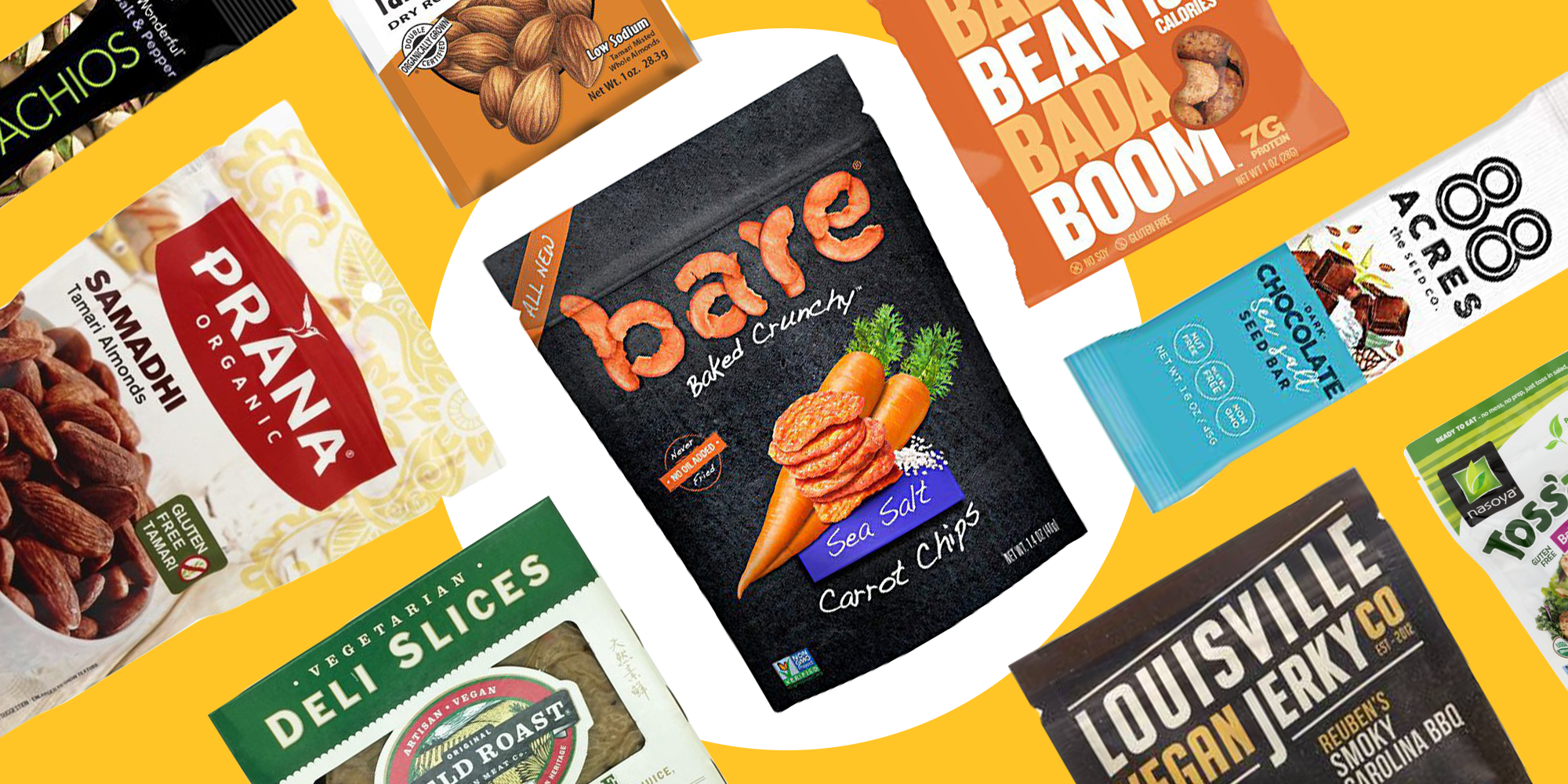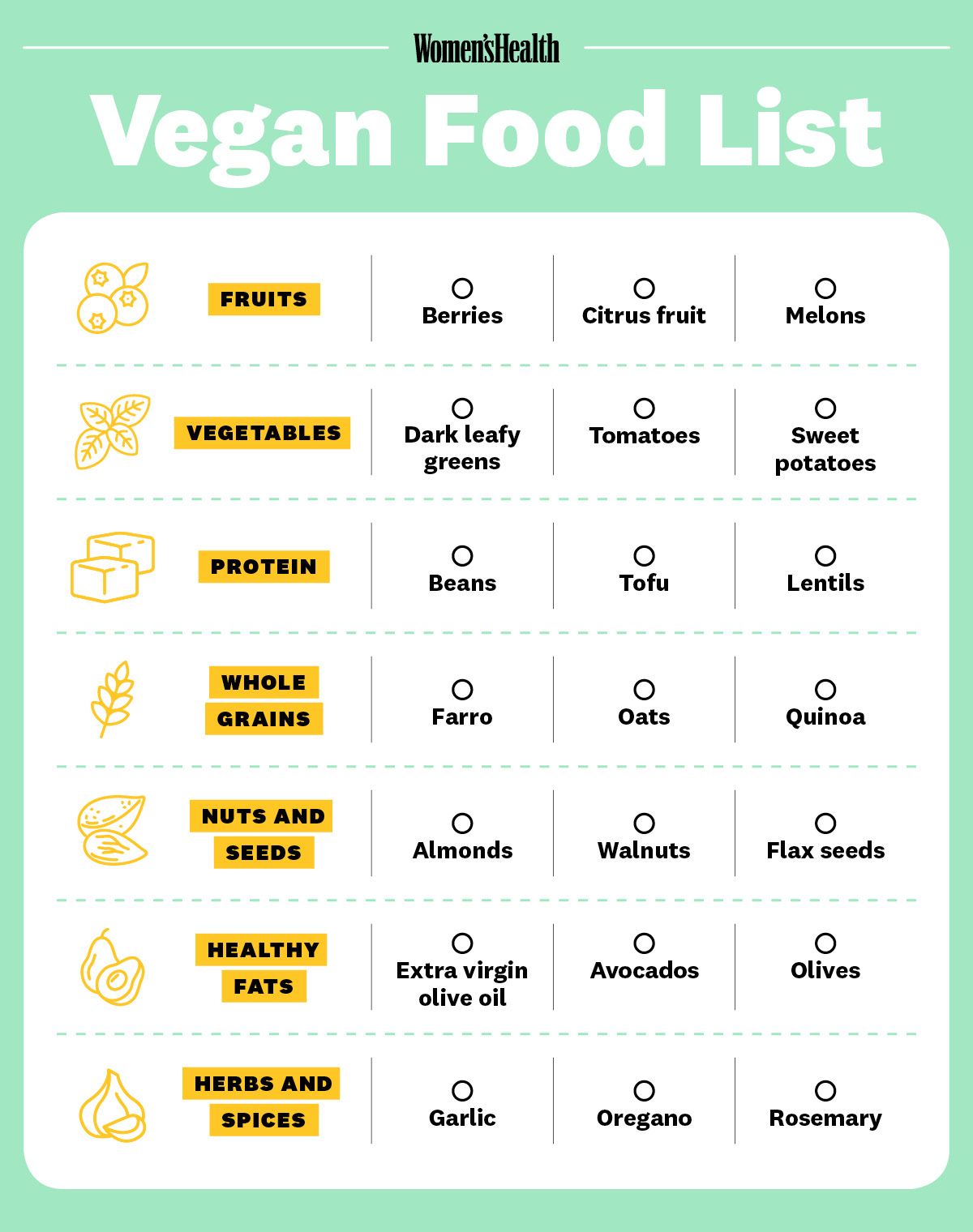Home » Diet & Food » Bring This Vegan Shopping List On Your Next Grocery Trip
Bring This Vegan Shopping List On Your Next Grocery Trip
Going vegan seems simple enough: You say goodbye to meat, poultry, fish, dairy, and eggs, then voilà—you’re a vegan. And then you eat…fruits and veggies? (Is that it? There’s got to be something else!)
Seriously though, what can you actually eat if you follow a vegan diet? And is it legit good for you to nix meat for plant-based foods? (Asking for all aspirational vegans, everywhere.)
Well, the vegan diet does come with perks—for your health and the environment.
Plant-based eating gets the biggest buzz for its health benefits. “Plant foods are often anti-inflammatory and they can also help regulate digestion. Eating more plants may also reduce a person’s risk for chronic conditions, including heart disease and diabetes,” says Stephanie McKercher, RDN. The nutrients in plants also promote healthy cholesterol, blood pressure, and blood sugar levels.
Plus, adopting a meat- and dairy-free way of eating is one of the best ways to reduce your impact on the environment, according to a study published in the journal Science. “Eating more plant foods reduces your carbon footprint since livestock production is responsible for a good portion of global greenhouse gas emissions,” Alexis Joseph, RD, previously told Women’s Health.
Plus, following a vegan diet isn’t as complicated as you think.
While swearing off meat and dairy seems like a good idea, you might be wondering: “Will I get enough protein? Will I be stuck eating tofu every day for the rest of my life? What the heck CAN I eat?”
Take a deep breath. Switching to a vegan diet isn’t as overwhelming as it may seem.
“One of the biggest misconceptions about vegan eating is that it’s too strict, but you can still have all of your favorite foods in their plant-based forms,” says McKercher. “Try oat milk instead of dairy milk, grill veggie burgers instead of beef patties, or use nutritional yeast instead of cheese.”



But opting for the plant-based life isn’t just about nixing animal products. You still need to meet all your nutrient needs by eating a variety of different foods—which could mean adding new foods to your diet.
To get all those nutrients, McKercher recommends a simple formula for every meal: Combine colorful produce with whole grains, healthy fats, and a plant-based source of protein. Think grain bowls—they’re easy to assemble and you can swap in a variety of ingredients so you’re not eating the same sad lunch salad every day.
And while you can find a vegan version of practically all your beloved foods, remember that not all plant-based foods are nutrient-dense. “Try to seek out whole foods as much as possible,” says McKercher. “It’s okay to work in processed vegan alternatives when you want them, but they aren’t necessarily any more nutritious than the conventional version of the foods they’re modeled after.”
Here are all the celebs who proudly follow a vegan diet:
And there is some leeway. You don’t have to go all-in if that doesn’t work for your lifestyle. “For some people, a flexitarian way of living—eating mostly plants but including some animal products once in a while—works best,” says McKercher. “If you’re feeling restricted by your vegan diet, I recommend working with a registered dietitian who has experience with plant-based cooking and meal planning.” Part-time veganism, anyone?
Use this vegan food list to make things easier.
If you’re interested in following a plant-based style of eating, it helps to have some go-to ingredients to add to your cart. If you need a little guidance, here’s your vegan diet grocery list:
 Jewelyn Butron
Jewelyn Butron
Fruits: Pile your cart full of any and all fresh fruit. Think apples, berries, citrus fruit, melons, bananas, and pears. McKercher likes to seek out local, seasonal fruit whenever possible. “Eating seasonally is one of the best ways to get maximum flavor and nutrition for the lowest cost,” she says. So check out what’s new at your local farmer’s market.
Vegetables: Any and all fresh vegetables are on the table too, like dark leafy greens, tomatoes, spinach, broccoli, bok choy, peas, mushrooms, Brussels sprouts, cauliflower, cucumbers, peppers, and summer squash. Root vegetables like sweet potatoes, potatoes, and acorn squash are good sources of complex carbs.
Protein: McKercher’s favorite vegan protein sources are beans, tempeh, tofu, lentils, and chickpeas. Green peas, edamame, and seitan are also staples every vegan should try. Don’t forget that whole grains, nuts, and seeds also contain some protein.
Whole Grains: Think brown rice, farro, oats, and whole wheat. Don’t forget about grains like quinoa, kamut, and spelt, either.
Nuts and Seeds: Almonds, cashews, walnuts, chia seeds, flax seeds, and hemp seeds are all staples in McKercher’s kitchen. Peanut butter, too! She adds nuts and seeds to everything from homemade crackers to smoothie bowls.
Healthy Fats: Extra virgin olive oil, avocados, avocado oil, walnut oil, olives
Herbs and Spices: Garlic, oregano, basil, thyme, mint, sage, rosemary, cinnamon, nutmeg, and more.
See, following a vegan diet is anything but limited. Seeya, beef!
Source: Read Full Article
-
 Giada De Laurentiis' 3-Ingredient Blood Orange Shandy Is Our Official Summer Cocktail
Jul 1, 2023
Giada De Laurentiis' 3-Ingredient Blood Orange Shandy Is Our Official Summer Cocktail
Jul 1, 2023 -
 Chipotle Is Charging for Tortillas on the Side, Putting an End to a Cult-Favorite Menu Hack
Oct 21, 2020
Chipotle Is Charging for Tortillas on the Side, Putting an End to a Cult-Favorite Menu Hack
Oct 21, 2020 -
 These Genius Mole Starter Kits Save You Hours in the Kitchen & Are Perfect for Jazzing up Costco Rotisserie Chicken
Oct 4, 2023
These Genius Mole Starter Kits Save You Hours in the Kitchen & Are Perfect for Jazzing up Costco Rotisserie Chicken
Oct 4, 2023 -
 I Was Today Years Old When I Found Out Decaf Coffee Still Contains Caffeine
Feb 15, 2020
I Was Today Years Old When I Found Out Decaf Coffee Still Contains Caffeine
Feb 15, 2020